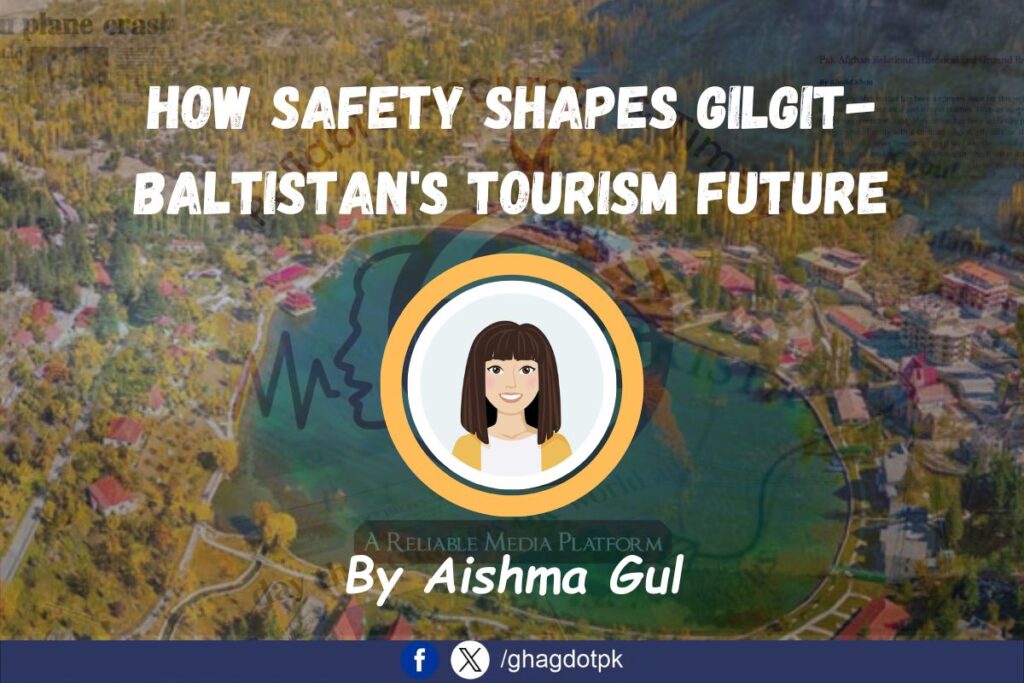By Aishma Gul
“A land’s beauty is only as enduring as the peace that guards it.”
Security: The Key to Tourism
The recent ranking of Gilgit-Baltistan (GB) within the world’s top-25 travel destinations for 2025 reflects Pakistan’s tourism potential, which is yet to be realised. Though its glacial lakes and mountains such as K2 loom large in imaginations, the region’s tourism trajectory depends on untangling security issues that keep global visitors at bay.
Security Challenges: Beyond the Obvious
1. Cross-Border Instability
Its strategic location adjacent to Afghanistan and the Line of Control (LoC) renders Gilgit-Baltistan a vulnerable region prone to cross-border militancy and smuggling networks.
2. Terrorism Residue
Groups like the TTP use remote areas to spread their message, despite efforts to stop them. The 2024 attack on tourists in Chilas, claimed by a local TTP group, showed how these remote areas are vulnerable.
3. Infrastructure as a Security Asset
Poor roads and limited connectivity aren’t just developmental failures—they’re security risks. Isolated areas become soft targets; the Karakoram Highway’s frequent closures due to landslides or security operations disrupt travel logistics.
4. Intelligence Gaps
Too many tourists put a strain on local police. Without quick sharing of important information between the military, police, and tourism officials, threats like local extremists or foreign spies taking advantage of visa-free zones (like in CPEC projects) can’t be stopped.
Military-Led Progress: Safe Tourism for All
1. In 2022, the Pakistan Army set up “Safe Tourism Zones” in Gilgit-Baltistan (GB). They placed Quick Response Forces (QRFs) and used aerial surveillance to keep tourists safe. This led to a 40% drop in security incidents on major routes (ISPR Report, 2023).
2. Security for the China-Pakistan Economic Corridor (CPEC) has also made tourism safer. Special teams patrol the Karakoram Highway, and hotels use biometric checks to ensure security for travellers.
3. Programs like “Explore Pakistan, Embrace Peace” help locals in GB fight extremist ideas. Retired soldiers lead guided tours, mixing history with messages of peace. The UN Counter-Terrorism Committee (2024)5 has praised this effort.
4. The Army uses drones in Skardu and AI-powered security checks at key points like Khunjerab Pass to keep tourists safe.
Remaining Risks & Smart Solutions
Hybrid threats, including disinformation campaigns, bring their challenges. Fake videos depicting GB to be “unsafe” do the rounds often, eating into perception gains. To combat this, a joint military-tourism cell could quickly disprove fake news and promote factual narratives through official channels.
Community-led models of intelligence sharing, such as “Tourism Watch Committees” in the Hunza Valley, hope to fill this void. On behalf of the army, these committees emerged and improved local vigilance. The ingenuity of such initiatives could be scaled province-wide to turn communities into force multipliers. Training police in tourist-centric crisis response — hostage and medical evacuations — is also vital. In Khyber Pakhtunkhwa, a pilot project in 2023, reduced emergency response times by 30%, a model success that can be replicated.
Military-built roads and tunnels, like the Swat Motorway and Neelum-Jhelum tunnels, should be seen as signs of stability. The Frontier Works Organization (FWO) has also built roads to far-off places like Fairy Meadows, making travel safer and boosting tourism.
Linking Security with Broader Reforms
Security remains the top priority, but collaboration with other sectors is just as important. Issues like unreliable air travel and a shortage of quality hotels highlight the need for better infrastructure. Road projects linked to CPEC can help improve connectivity. Managing public perception is also crucial—one way to do this is through military diplomacy. For example, inviting international climbers on Army-supported K2 expeditions could help reshape Pakistan’s image as a safe travel destination.
Fragile environments like the Deosai Plains are at risk of environmental damage, making military engineering expertise essential. Army teams could be deployed to develop waste management systems, which would not only protect these ecosystems but also demonstrate institutional responsibility. Encouraging community-based tourism, such as training local guides, can create economic opportunities and help prevent radicalization.
Safety Opens the Door to Progress
Gilgit-Baltistan’s growing international recognition presents both an opportunity and a challenge. For Pakistan, tourism is more than just a source of income—it is crucial for national security. The military has played a key role in ensuring safety, but long-term success requires a stronger connection between security measures and tourism strategies. By tackling modern threats, involving local communities, and demonstrating stability through improved infrastructure, Pakistan can transform its northern regions into a model for safe and sustainable tourism. The world is paying attention, and now is the time to take action.






